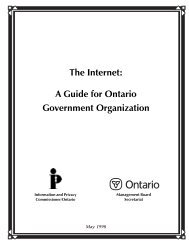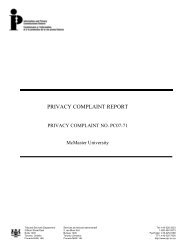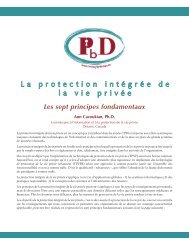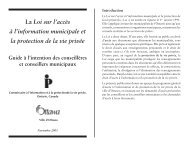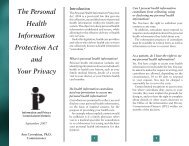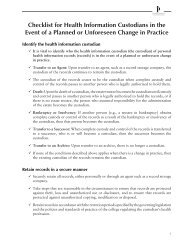Privacy and Boards of Directors: What You Don't Know Can Hurt You
Privacy and Boards of Directors: What You Don't Know Can Hurt You
Privacy and Boards of Directors: What You Don't Know Can Hurt You
You also want an ePaper? Increase the reach of your titles
YUMPU automatically turns print PDFs into web optimized ePapers that Google loves.
<strong>Privacy</strong> <strong>and</strong> <strong>Boards</strong> <strong>of</strong><br />
<strong>Directors</strong>:<br />
<strong>What</strong> <strong>You</strong> Don’t <strong>Know</strong><br />
<strong>Can</strong> <strong>Hurt</strong> <strong>You</strong><br />
Information <strong>and</strong> <strong>Privacy</strong><br />
Commissioner <strong>of</strong> Ontario<br />
Ann Cavoukian, Ph.D.<br />
Commissioner<br />
July 2007
This publication is an updated, enhanced version <strong>of</strong> a paper<br />
released in 2003 by Dr. Ann Cavoukian, Information <strong>and</strong> <strong>Privacy</strong><br />
Commissioner <strong>of</strong> Ontario. Dr. Cavoukian gratefully acknowledges<br />
the work <strong>of</strong> Pr<strong>of</strong>essor Richard LeBlanc <strong>of</strong> the Schulich School <strong>of</strong><br />
Business, York University, <strong>and</strong> Debra Grant <strong>of</strong> the IPC, in preparing<br />
the first report, <strong>and</strong> Catherine Thompson <strong>of</strong> the IPC for her work<br />
on this updated report.<br />
Information <strong>and</strong> <strong>Privacy</strong><br />
Commissioner <strong>of</strong> Ontario<br />
2 Bloor Street East<br />
Suite 1400<br />
Toronto, Ontario<br />
M4W 1A8<br />
CANADA<br />
416-326-3333<br />
1-800-387-0073<br />
Fax: 416-325-9195<br />
TTY (Teletypewriter): 416-325-7539<br />
Website: www.ipc.on.ca<br />
This publication is also available on the IPC website.
Information <strong>and</strong> <strong>Privacy</strong><br />
Commissioner <strong>of</strong> Ontario<br />
Table <strong>of</strong> Contents<br />
Executive Summary................................................................................................ 1<br />
Introduction.......................................................................................................... 2<br />
Culture <strong>of</strong> privacy.................................................................................................. 4<br />
Learning from privacy breaches............................................................................. 5<br />
<strong>What</strong> are Fair Information Practices?..................................................................... 7<br />
<strong>What</strong> are the Potential Risks <strong>of</strong> Failing to Address <strong>Privacy</strong>?................................... 9<br />
<strong>What</strong> is the Business Case for Sound <strong>Privacy</strong> Practices?....................................... 16<br />
<strong>What</strong> Should <strong>Directors</strong> Do?................................................................................. 19<br />
Questions <strong>Directors</strong> Should Ask to Ensure <strong>Privacy</strong> Compliance........................... 22
Information <strong>and</strong> <strong>Privacy</strong><br />
Commissioner <strong>of</strong> Ontario<br />
Executive Summary<br />
The Information <strong>and</strong> <strong>Privacy</strong> Commissioner <strong>of</strong> Ontario, Ann Cavoukian, Ph.D., prepared this<br />
paper to raise awareness among corporate boards <strong>of</strong> directors about privacy. As a director,<br />
you face increased responsibilities, which now include ensuring that customer personal<br />
information is h<strong>and</strong>led with care. Recent high pr<strong>of</strong>ile data breaches show what can happen<br />
if privacy is left as an afterthought. The central message <strong>of</strong> this paper is that you cannot<br />
afford risking the serious harm to customers from lost or stolen data, as well as the potential<br />
liability <strong>and</strong> loss <strong>of</strong> business resulting from a breach.<br />
This paper explains the importance <strong>of</strong> creating a culture <strong>of</strong> privacy within your organization.<br />
Fair information practices are also explained. They are a set <strong>of</strong> commonly accepted principles<br />
that organizations should apply to personal information in order to protect privacy – <strong>and</strong><br />
that also form the basis <strong>of</strong> laws <strong>and</strong> policies related to privacy. These practices relate to<br />
accountability, identifying purposes, consent, limiting various activity (such as collection, use,<br />
disclosure, <strong>and</strong> retention <strong>of</strong> personal information), accuracy, safeguards, openness, access,<br />
<strong>and</strong> challenging compliance.<br />
From a business perspective, the failure to address privacy can harm your reputation, your<br />
organization’s reputation, <strong>and</strong> business relationships. It can also seriously harm your customers,<br />
<strong>and</strong> lead to customer mistrust <strong>and</strong> deterioration in your organization’s information asset<br />
quality. Moreover, it can lead to a loss in market share, unexpected costs, <strong>and</strong> a drop in<br />
stock prices.<br />
To assist in better underst<strong>and</strong>ing the importance <strong>of</strong> addressing privacy, this paper outlines the<br />
business case for sound privacy practices. The paper argues that sound privacy practices will<br />
give your organization a more positive image <strong>and</strong> a significant edge over the competition. Also,<br />
business development into other jurisdictions with privacy laws can be facilitated. Products<br />
<strong>and</strong> services can be customized to meet customer needs <strong>and</strong> will enhance strategic decisions.<br />
Moreover, good privacy practices will enhance customer loyalty, <strong>and</strong> will ultimately save you<br />
time <strong>and</strong> money. Treating privacy as a strategic business differentiator creates a positive sum<br />
scenario where the interests <strong>of</strong> both your organization <strong>and</strong> your customers are advanced.<br />
The paper outlines specific steps you should take, including a self-assessment, educating<br />
yourself regarding privacy, appointing a Chief <strong>Privacy</strong> Officer, making privacy an integral<br />
part <strong>of</strong> performance evaluations <strong>and</strong> compensation packages, executing regular privacy<br />
audits, <strong>and</strong> asking senior management the right questions about privacy.<br />
1
Information <strong>and</strong> <strong>Privacy</strong><br />
Commissioner <strong>of</strong> Ontario<br />
Introduction<br />
Today, corporate directors are faced with a wide array <strong>of</strong> responsibilities arising from their board<br />
membership. For example, the far-reaching Sarbanes-Oxley Act passed in 2002 significantly<br />
reformed corporate responsibility in the United States by introducing requirements aimed at<br />
improving the accuracy <strong>and</strong> reliability <strong>of</strong> corporate disclosures to investors. <strong>Directors</strong> also<br />
have a fiduciary duty to act in the best interests <strong>of</strong> the corporation <strong>and</strong> a duty to maintain<br />
an appropriate st<strong>and</strong>ard <strong>of</strong> care. In <strong>Can</strong>ada, the statutory st<strong>and</strong>ard for the amount <strong>of</strong> care,<br />
diligence <strong>and</strong> skill required <strong>of</strong> directors is codified at section 134(1) <strong>of</strong> the Ontario Business<br />
Corporations Act 1 <strong>and</strong> section 122(1) <strong>of</strong> the <strong>Can</strong>adian Business Corporations Act. 2 Both Acts<br />
state directors must “exercise the care, diligence <strong>and</strong> skill that a reasonably prudent person<br />
would exercise in comparable circumstances.”<br />
To enhance awareness among boards <strong>of</strong> the need to protect clients’ privacy, the Information<br />
<strong>and</strong> <strong>Privacy</strong> Commissioner/Ontario (the IPC) has prepared this paper for dissemination to<br />
directors. The purpose <strong>of</strong> this paper is to raise awareness <strong>of</strong> privacy not only as a compliance<br />
issue but also as a business issue. In doing so, we hope to promote the underst<strong>and</strong>ing that<br />
oversight <strong>of</strong> an organization’s privacy compliance policies <strong>and</strong> procedures is an integral <strong>and</strong><br />
necessary component <strong>of</strong> effective board service.<br />
A lack <strong>of</strong> attention to privacy can have a number <strong>of</strong> adverse consequences for which directors<br />
may be held accountable. The degree <strong>of</strong> risk will vary from one organization to the next,<br />
depending on the nature <strong>of</strong> the business <strong>and</strong> the amount <strong>of</strong> personal information that is<br />
collected, used <strong>and</strong> disclosed. The potential consequences include:<br />
• damage to the organization’s reputation <strong>and</strong> br<strong>and</strong>;<br />
• physical, psychological <strong>and</strong> economic harm to customers whose personal information<br />
is used or disclosed inappropriately;<br />
• financial losses associated with deterioration in the quality <strong>and</strong> integrity <strong>of</strong> personal<br />
information due to customer mistrust;<br />
• loss <strong>of</strong> market share or a drop in stock prices following a “privacy hit” resulting in<br />
negative publicity or the failure or delay in the implementation <strong>of</strong> a new product or<br />
service due to privacy concerns.<br />
1 R.S.O. 1990, c. B.16<br />
2 R.S.C. 1985, c. C-44<br />
2
Information <strong>and</strong> <strong>Privacy</strong><br />
Commissioner <strong>of</strong> Ontario<br />
Careful attention to privacy issues may not only help directors <strong>and</strong> their organizations to<br />
avoid these risks, but may also have a number <strong>of</strong> positive effects. The potential benefits <strong>of</strong><br />
implementing sound privacy policies <strong>and</strong> practices include:<br />
• consumer confidence <strong>and</strong> trust;<br />
• a more positive organizational image <strong>and</strong> a significant edge over the competition;<br />
• business development through expansion into jurisdictions requiring clear privacy<br />
st<strong>and</strong>ards;<br />
• enhanced data quality <strong>and</strong> integrity, fostering better customer service <strong>and</strong> more strategic<br />
business decision-making;<br />
• enhanced customer trust <strong>and</strong> loyalty; <strong>and</strong><br />
• savings in terms <strong>of</strong> time <strong>and</strong> money.<br />
The remainder <strong>of</strong> the paper is divided into six sections. The first section describes what<br />
is meant by a “culture <strong>of</strong> privacy.” The second describes the challenges <strong>of</strong> publicized data<br />
breaches. The third describes basic fair information practices – the foundation for privacy.<br />
The fourth section describes the potential risks that directors <strong>and</strong> <strong>of</strong>ficers take when they<br />
fail to pay close enough attention to privacy in their organizations. The fifth describes some<br />
<strong>of</strong> the potential benefits that can be reaped through the implementation <strong>of</strong> sound privacy<br />
policies <strong>and</strong> practices. The final section sets out recommendations for what directors should<br />
do to promote privacy compliance in their organizations. The paper concludes with a list <strong>of</strong><br />
questions directors should ask senior management about the privacy policies <strong>and</strong> practices<br />
in their organizations to ensure privacy compliance.<br />
3
Information <strong>and</strong> <strong>Privacy</strong><br />
Commissioner <strong>of</strong> Ontario<br />
Culture <strong>of</strong> privacy<br />
Increasingly, privacy is one <strong>of</strong> the key issues on which directors must focus in order to execute<br />
their compliance <strong>and</strong> managerial oversight as well as mitigate risk. <strong>Privacy</strong> is <strong>of</strong>ten defined<br />
as the right <strong>of</strong> individuals to control the collection, use <strong>and</strong> disclosure <strong>of</strong> their own personal<br />
information (i.e., information that relates to an identifiable individual). Organizations can<br />
help to protect an individual’s privacy by implementing what are commonly referred to as fair<br />
information practices as part <strong>of</strong> an overall culture <strong>of</strong> privacy. Such a culture moves beyond<br />
legislation, regulation <strong>and</strong> policy to help ensure that errors do not occur. It also provides<br />
the necessary imperative to promptly detect <strong>and</strong> correct errors if they do occur. Thorough<br />
training, ongoing monitoring, auditing, <strong>and</strong> regular evaluation are key components <strong>of</strong> a<br />
culture <strong>of</strong> privacy.<br />
Telling your executive team to “Make us privacy compliant” is not enough. 3 <strong>Directors</strong> must<br />
be more engaged, approve their company’s privacy plan, <strong>and</strong> require regular report backs.<br />
It is also important to treat privacy as a business issue <strong>and</strong> not as a compliance issue. If you<br />
make privacy part <strong>of</strong> your business strategy, then it will be infused in your work plan <strong>and</strong><br />
your staff will come on board fully. However, if you treat it solely as a compliance issue,<br />
then you will be doing the minimum necessary, <strong>and</strong> seldom advancing privacy as you would<br />
if you viewed it as a strategic business differentiator.<br />
3 See, for example, Thomas J. Smedingh<strong>of</strong>f, “Director Responsibilities for Data Security: Key Questions the<br />
Board Should Ask,” <strong>Directors</strong> Monthly (April 2007).<br />
4
Information <strong>and</strong> <strong>Privacy</strong><br />
Commissioner <strong>of</strong> Ontario<br />
Learning from privacy breaches<br />
New information technology, the globalization <strong>of</strong> the economy, the interconnectivity <strong>of</strong><br />
businesses, <strong>and</strong> web-based delivery <strong>of</strong> products <strong>and</strong> services pose challenges to the protection<br />
<strong>of</strong> personal information. These challenges are reflected in a number <strong>of</strong> well-publicized<br />
privacy breaches.<br />
In a truly regrettable incident, a patient admitted to an Ontario hospital made a specific<br />
request to ensure her estranged husb<strong>and</strong>, who worked at that hospital, <strong>and</strong> his girlfriend, a<br />
nurse at the hospital, did not become aware <strong>of</strong> her hospitalization, <strong>and</strong> that steps be taken to<br />
protect her privacy. The patient later learned that the nurse had repeatedly <strong>and</strong> surreptitiously<br />
accessed her electronic health record both before <strong>and</strong> after she filed a privacy complaint<br />
with the hospital’s privacy <strong>of</strong>fice. Although her file was flagged with a privacy warning for<br />
those seeking access, the nurse was still able to see the patient’s file by clicking “yes” to a<br />
“Do you wish to continue?” prompt. Following the hospital’s report on this incident, the<br />
patient filed a complaint with the IPC, which resulted in an order requiring the hospital to<br />
overhaul its privacy practices. 4<br />
Further examples <strong>of</strong> repeated breaches include those at TJ Maxx <strong>and</strong> the <strong>Can</strong>adian Imperial<br />
Bank <strong>of</strong> Commerce (CIBC). The TJ Maxx breach began in July 2005 when one or more<br />
intruders stole 45.7 million customer credit <strong>and</strong> debit card numbers. Data was stolen<br />
repeatedly from 2005 to 2007. 5 CIBC experienced a repeated breach from 2001 to 2004<br />
when misdirected faxes with confidential customer information were sent to a West Virginia<br />
scrap yard despite repeated calls from the owner to have the faxes stopped. 6 And in January<br />
2007, CIBC’s subsidiary Talvest Mutual Funds lost 470,000 pieces <strong>of</strong> customer account<br />
information. 7<br />
Since incidents such as these can have serious consequences for both the individuals whose<br />
privacy is breached <strong>and</strong> the organization that is responsible for the breach, questions have<br />
been raised about the liability risks <strong>of</strong> directors in protecting the personal information<br />
collected, used <strong>and</strong> disclosed by their organizations. For example, criminal charges were<br />
laid against Hewlett-Packard’s Chair <strong>of</strong> the Board following surveillance <strong>of</strong> several board<br />
members, which included access to their telephone records.<br />
4 Order HO-002 (July 27, 2006), Information <strong>and</strong> <strong>Privacy</strong> Commissioner/Ontario Decision: http://www.ipc.<br />
on.ca/images/Findings/up-HO_002.pdf.<br />
5 Joseph Pereira, “Breaking the Code: How Credit-Card Data Went Out Wireless Door,” The Wall Street Journal<br />
(4 May 2007).<br />
6 Addendum to CIBC fax incident summary: Summary <strong>of</strong> Investigations (April 18, 2005), Office <strong>of</strong> the <strong>Privacy</strong><br />
Commissioner <strong>of</strong> <strong>Can</strong>ada: http://www.privcom.gc.ca/incidents/2005/050418_02_e.asp.<br />
7 “CIBC loses data on 470,000 Talvest fund customers,” <strong>Can</strong>adian Broadcasting Corporation (January 18, 2007),<br />
CBC: http://www.cbc.ca/money/story/2007/01/18/cibc.html.<br />
5
Information <strong>and</strong> <strong>Privacy</strong><br />
Commissioner <strong>of</strong> Ontario<br />
Most <strong>Can</strong>adian organizations are required to comply with either federal or provincial privacy<br />
legislation. In addition, those conducting business in the U.S. must ensure compliance with<br />
data breach notification laws first passed by California in 2002 <strong>and</strong> currently in force in most<br />
states. 8 Legislation <strong>and</strong> the potential risk <strong>of</strong> harm from privacy breaches are not, however, the<br />
only factors compelling directors to pay closer attention to privacy issues. Research shows<br />
that consumers are becoming increasingly concerned, better informed <strong>and</strong> more dem<strong>and</strong>ing<br />
with regards to the protection <strong>of</strong> their personal information. Studies show that consumer<br />
trust translates into customer retention, a competitive advantage, <strong>and</strong> a willingness to pay<br />
more if customers know that their privacy will be protected. 9 The opposite is also true.<br />
Surveys show that consumers will alter their purchasing behaviour, adversely for the interests<br />
<strong>of</strong> the business involved, if they no longer trust an organization to manage their personal<br />
information appropriately. According to 2006 statistics data loss can translate into an eight<br />
per cent loss <strong>of</strong> customers <strong>and</strong> a corresponding decrease <strong>of</strong> eight per cent in revenue, plus<br />
$100 in expenses per customer for notification <strong>and</strong> restoring data. 10<br />
8 See, for example, the National Conference <strong>of</strong> State Legislatures page on data breach notification laws: http://<br />
www.ncsl.org/programs/lis/cip/priv/breachlaws.htm.<br />
9 See, for example: IT Policy Compliance Group, “Taking Action to Protect Sensitive Data: Benchmark Research<br />
Report” (February 2007); Ponemon Institute, LLC, “<strong>Privacy</strong> Trust Survey for Online Banking” (April 5, 2005). See<br />
also coverage <strong>of</strong> the 2007 TriCipher Consumer Online Banking Study conducted by Javelin Strategy & Research:<br />
“Consumers Value ID Theft Prevention Over Financial Reimbursement,” Insurance Journal (April 10, 2007): http://<br />
www.insurancejournal.com/news/national/2007/04/10/78595.htm; “Fear Of Identity Theft Discourages Consumers<br />
From Banking Online” Bank Systems & Technology (May 8, 2007): http://www.banktech.com. In addition, see Don<br />
Peppers <strong>and</strong> Martha Rogers, Ph.D., Return on Customer: Creating Maximum Value From <strong>You</strong>r Scarcest Resource,<br />
(R<strong>and</strong>om House Inc., 2005) Chapter 12, “Violate your customer’s trust <strong>and</strong> kiss your asset good-bye.”<br />
10 IT Policy Compliance Group, “Taking Action to Protect Sensitive Data: Benchmark Research Report” (February<br />
2007).<br />
6
Information <strong>and</strong> <strong>Privacy</strong><br />
Commissioner <strong>of</strong> Ontario<br />
<strong>What</strong> are Fair Information Practices?<br />
Fair information practices are a set <strong>of</strong> common st<strong>and</strong>ards that balance an individual’s right<br />
to privacy with the organization’s legitimate need to collect, use <strong>and</strong> disclose personal<br />
information. In <strong>Can</strong>ada, fair information practices are set out in the <strong>Can</strong>adian St<strong>and</strong>ards<br />
Association Model Code for the Protection <strong>of</strong> Personal Information (the CSA Code).<br />
The CSA Code is incorporated into federal private sector privacy legislation, the Personal<br />
Information Protection <strong>and</strong> Electronic Documents Act. As <strong>of</strong> January 1, 2004, all private sector<br />
organizations in <strong>Can</strong>ada that collect, use or disclose personal information during the course<br />
<strong>of</strong> commercial activity have been subject to the federal legislation, except in jurisdictions that<br />
have substantially similar provincial legislation such as Alberta, British Columbia <strong>and</strong> Quebec.<br />
Ontario’s Personal Health Information Protection Act is also designated as substantially similar<br />
under the Personal Information Protection <strong>and</strong> Electronic Documents Act.<br />
The CSA Code consists <strong>of</strong> 10 principles. First, it requires the designation <strong>of</strong> at least one<br />
individual who is accountable for the organization’s compliance with the other nine principles<br />
(Accountability). The organization must specify the purposes for which it collects personal<br />
information, at or before the time when the information is collected (Identifying Purposes).<br />
The consent <strong>of</strong> the individual must be obtained for the collection, use or disclosure <strong>of</strong><br />
personal information, except where it is not appropriate to obtain consent (Consent). The<br />
collection <strong>of</strong> personal information must be limited to that which is necessary to fulfil the<br />
specified purposes (Limiting Collection). Personal information must not be used or disclosed<br />
for purposes other than those for which it was collected, unless the individual consents or<br />
as required by law (Limiting Use, Disclosure, <strong>and</strong> Retention). Personal information must<br />
be as accurate, complete <strong>and</strong> up-to-date as necessary for the purposes for which it is to be<br />
used (Accuracy). The organization must implement security safeguards that are appropriate<br />
for the level <strong>of</strong> sensitivity <strong>of</strong> the personal information (Safeguards). The organization must<br />
make readily available specific information about its policies <strong>and</strong> practices relating to the<br />
management <strong>of</strong> personal information (Openness). Individuals have a right to access <strong>and</strong> request<br />
correction <strong>of</strong> their own personal information (Individual Access). Finally, individuals must<br />
be able to challenge an organization’s compliance with the privacy principles (Challenging<br />
Compliance).<br />
A single Global <strong>Privacy</strong> St<strong>and</strong>ard (GPS) was developed last year after my <strong>of</strong>fice, <strong>and</strong> a Working<br />
Group <strong>of</strong> Commissioners I chaired, harmonized leading privacy practices <strong>and</strong> codes from<br />
around the world. The final version <strong>of</strong> the GPS was formally tabled <strong>and</strong> accepted in 2006 at<br />
the 28th International Data Protection Commissioners Conference, in the United Kingdom.<br />
The GPS builds upon the strengths <strong>of</strong> existing codes containing time-honoured privacy<br />
7
Information <strong>and</strong> <strong>Privacy</strong><br />
Commissioner <strong>of</strong> Ontario<br />
principles <strong>and</strong>, for the first time, reflects a noteworthy enhancement by explicitly recognizing<br />
the concept <strong>of</strong> “data minimization” under the collection limitation principle. 11<br />
<strong>Directors</strong> should be familiar with the Generally Accepted <strong>Privacy</strong> Principles (GAPP) developed<br />
by the American Institute <strong>of</strong> Certified Public Accountants <strong>and</strong> the <strong>Can</strong>adian Institute <strong>of</strong><br />
Chartered Accountants. 12 GAPP is based on fair information practices, <strong>and</strong> specifically<br />
details the management component, which says that an organization must define, document,<br />
communicate, <strong>and</strong> assign accountability for its privacy policies <strong>and</strong> procedures.<br />
<strong>Directors</strong> would be proactive in satisfying their duties by assessing whether senior management<br />
has successfully implemented these practices in their organizations. A list <strong>of</strong> questions based<br />
on these principles that a director might ask is presented at the end <strong>of</strong> this document. It<br />
should be noted that the limitations placed on the collection, use <strong>and</strong> disclosure <strong>of</strong> personal<br />
information will, in many cases, require modification to existing information management<br />
practices.<br />
11 See Creation <strong>of</strong> a Global <strong>Privacy</strong> St<strong>and</strong>ard, by Commissioner Ann Cavoukian, Ph.D., Information <strong>and</strong> <strong>Privacy</strong><br />
Commission/Ontario: http://www.ipc.on.ca/images/Resources/up-gps.pdf.<br />
12 Generally Accepted <strong>Privacy</strong> Principles, American Institute <strong>of</strong> Certified Public Accountants: http://infotech.<br />
aicpa.org/Resources/<strong>Privacy</strong>/Generally+Accepted+<strong>Privacy</strong>+Principles/.<br />
8
Information <strong>and</strong> <strong>Privacy</strong><br />
Commissioner <strong>of</strong> Ontario<br />
<strong>What</strong> are the Potential Risks <strong>of</strong> Failing to Address<br />
<strong>Privacy</strong>?<br />
1. A privacy breach could be damaging to you <strong>and</strong> your organization’s reputation<br />
<strong>and</strong> business relationships<br />
A significant privacy breach could lead to unwanted publicity <strong>and</strong> additional scrutiny <strong>of</strong><br />
you <strong>and</strong> your organization. Even in cases where media attention can be avoided, a formal<br />
complaint to the <strong>Privacy</strong> Commissioner could result in adverse information about your<br />
organization becoming public. This could lead to further unwanted scrutiny by both privacy<br />
<strong>and</strong> consumer advocates.<br />
<strong>Directors</strong> have a duty to act with the st<strong>and</strong>ard <strong>of</strong> care that a reasonably prudent person would<br />
exercise in similar circumstances. <strong>Directors</strong> can look to the federal privacy legislation for<br />
guidance on the st<strong>and</strong>ard <strong>of</strong> care that organizations should adhere to in protecting personal<br />
information. Companies <strong>and</strong> their directors may be sued for negligence if they have failed<br />
to conform to the required st<strong>and</strong>ard <strong>of</strong> care in their actions or inactions.<br />
In addition, the U.S. federal Trade Commission has looked to the following practices, as a<br />
whole, to determine that a company failed to provide reasonable <strong>and</strong> appropriate security<br />
for sensitive customer information: 13<br />
• created unnecessary risks to sensitive information by storing it in multiple files when<br />
it no longer had a business need to keep the information;<br />
• failed to use readily available security measures to limit access to its computer networks<br />
through wireless access points on the networks;<br />
• stored the information in unencrypted files that could be easily accessed using a<br />
commonly known user ID <strong>and</strong> password;<br />
• failed to limit sufficiently the ability <strong>of</strong> computers on one in-store network to connect<br />
to computers on other in-store <strong>and</strong> corporate networks; <strong>and</strong><br />
• failed to employ sufficient measures to detect unauthorized access.<br />
Since adverse publicity arising from privacy breaches could have an impact on stock prices,<br />
shareholders may question whether the directors <strong>of</strong> an organization have conformed to<br />
the st<strong>and</strong>ard <strong>of</strong> care in acting or failing to act – this could lead to shareholder-initiated<br />
lawsuits.<br />
13 DSW Inc. F.T.C. File No. 052 3096 (March 7, 2006). See also BJ’s Wholesale Club, Inc., F.T.C. File No.<br />
0423160 (September 20, 2005).<br />
9
Information <strong>and</strong> <strong>Privacy</strong><br />
Commissioner <strong>of</strong> Ontario<br />
The interconnectivity <strong>of</strong> businesses adds an additional layer <strong>of</strong> risk. Where businesses<br />
are working collaboratively on partnering <strong>and</strong> joint initiatives, privacy should be a major<br />
consideration. Businesses that have made a commitment to privacy protection will not want<br />
to expose themselves to risk through associations or partnerships with organizations that<br />
fail to conform to the required st<strong>and</strong>ard <strong>of</strong> care in protecting personal information. The<br />
Wall Street Journal reported in May 2007 that following the TJ Maxx breach “banks could<br />
spend $300 million to replace cards from just one year’s worth <strong>of</strong> stolen numbers,” <strong>and</strong> that<br />
the breach could total $20 million in fraudulent transactions. 14 Questions are being raised<br />
about whether a regulatory response should require businesses to reimburse banks for costs<br />
they incur from a business’ data breach. 15<br />
<strong>Directors</strong> will want to ensure that privacy is a key consideration when their organizations enter<br />
into partnership arrangements, or when contractual arrangements are made with companies<br />
for the provision <strong>of</strong> specific services (e.g., information technology). An organization cannot<br />
avoid their privacy obligations by outsourcing to third parties, <strong>and</strong> may be held liable if<br />
agents <strong>and</strong> service providers fail to comply with privacy legislation. Conversely, to avoid<br />
lawsuits initiated by business partners, organizations should take reasonable steps to meet<br />
the minimum requirements for privacy protection set out in all contractual agreements with<br />
third parties <strong>and</strong> in privacy legislation.<br />
In addition, to help minimize the damage following a privacy breach, directors should ensure<br />
that their organizations have a privacy crisis management protocol in place. The protocol<br />
should ensure that, following a privacy breach, appropriate steps are taken to minimize the<br />
damage to you <strong>and</strong> your organization’s reputation <strong>and</strong> business relationships <strong>and</strong> to prevent<br />
similar breaches in the future. As part <strong>of</strong> the protocol, directors should be kept informed<br />
about all privacy breaches.<br />
2. A privacy breach could result in serious harm to your customers<br />
<strong>Directors</strong> need not only be concerned about the potential threat <strong>of</strong> lawsuits initiated by<br />
shareholders <strong>and</strong> business partners following a privacy incident. A privacy breach could also<br />
potentially expose you, your organization <strong>and</strong> your business partners to lawsuits initiated<br />
by customers who are the victims <strong>of</strong> a privacy breach.<br />
Launching class-action lawsuits stemming from privacy breaches has emerged as a new<br />
litigation trend. In many situations, companies that have inadvertently used or disclosed<br />
14 Joseph Pereira, “Breaking the Code: How Credit-Card Data Went Out Wireless Door,” The Wall Street Journal<br />
(4 May 2007).<br />
15 For example, the TJ Maxx breach triggered the introduction <strong>of</strong> a bill this year in the company’s home state<br />
<strong>of</strong> Massachusetts. See H.B. 213, “An Act Relative to Enhancing the Confidentiality <strong>and</strong> Protection <strong>of</strong> Certain<br />
Customer Information,” 185 th Gen. Court, Reg. Sess., Mass., 2007.<br />
10
Information <strong>and</strong> <strong>Privacy</strong><br />
Commissioner <strong>of</strong> Ontario<br />
the personal information <strong>of</strong> individuals without their consent have subsequently been sued.<br />
For example, the legal fallout from TJ Maxx’s loss <strong>of</strong> 45.7 million customer credit <strong>and</strong><br />
debit card numbers includes challenges from customers, shareholders – <strong>and</strong> banks wanting<br />
reimbursement for the cost <strong>of</strong> replacing cards. 16 The potential for serious harm is recognized<br />
by the U.S. Federal Trade Commission which has found that it is an unfair practice to fail<br />
to secure customers’ sensitive information because it can cause substantial injury that a<br />
consumer cannot reasonably avoid. 17<br />
Individuals may suffer a range <strong>of</strong> harms from the unauthorized or inappropriate collection,<br />
use <strong>and</strong> disclosure <strong>of</strong> their personal information. One <strong>of</strong> the more widespread harms is the<br />
unwanted intrusion into our lives from junk mail, spam <strong>and</strong> telemarketing. But, individuals<br />
can also be exposed to more serious risks including physical, psychological <strong>and</strong> economic<br />
harm. Unauthorized disclosures <strong>of</strong> seemingly innocuous personal information, such as<br />
address <strong>and</strong> telephone number, can expose some individuals, including children, to the risk<br />
<strong>of</strong> physical harm from stalkers, abusive partners, or sexual predators.<br />
Individuals can be humiliated or stigmatized through the disclosure <strong>of</strong> personal information<br />
relating to medical or psychiatric conditions, alcohol or drug addiction, or financial status.<br />
Unauthorized disclosures <strong>of</strong> certain types <strong>of</strong> personal information to some third parties can<br />
lead to a loss <strong>of</strong> opportunities in terms <strong>of</strong> employment, insurance, housing, <strong>and</strong> other benefits<br />
<strong>and</strong> services. Furthermore, if an organization does not take appropriate steps to guard against<br />
it, personal information that is inaccurate, incomplete or out-<strong>of</strong>-date could be used to make<br />
administrative decisions that adversely affect individuals. For example, inaccurate financial<br />
information could be used to deny an individual access to credit.<br />
Identity theft is another growing risk that needs to be addressed. If your organization fails<br />
to implement adequate privacy <strong>and</strong> security safeguards, this may open the door to identity<br />
thieves who attempt to gain access to enough personal information to assume the identity<br />
<strong>of</strong> another person, usually for the purpose <strong>of</strong> committing crimes in that person’s name.<br />
Identity thieves may go on spending sprees, take over bank accounts, open new accounts,<br />
divert financial mail, rent apartments, <strong>and</strong> apply for loans, credit cards, utilities <strong>and</strong> social<br />
benefits – all at the expense <strong>of</strong> their victims! Victims <strong>of</strong> identity thieves are <strong>of</strong>ten left without<br />
any credit, their reputations in ruins <strong>and</strong> may even be arrested for the crimes <strong>of</strong> the persons<br />
who impersonated them. With a poor credit rating, a victim may be denied a job, a loan,<br />
or rental housing. 18<br />
16 Bill Brenner, “Banks prepare lawsuit over TJX data breach,” Security Search (25 April 2007): http://searchsecurity.<br />
techtarget.com.<br />
17 Federal Trade Commission, News Release/Communiqué, “BJ’S Wholesale Club Settles FTC Charges” (16<br />
June 2005): http://www.ftc.gov/opa/2005/06/bjswholesale.shtm.<br />
18 See, for example, the <strong>Can</strong>adian Internet Policy <strong>and</strong> Public Interest Clinic’s Identity Theft: Introduction <strong>and</strong><br />
Background Working Paper No. 1 (ID Theft Series): http://www.cippic.ca/en/bulletin/Introduction.pdf.<br />
11
Information <strong>and</strong> <strong>Privacy</strong><br />
Commissioner <strong>of</strong> Ontario<br />
The Solicitor General reports that identity theft is one <strong>of</strong> the fastest growing crimes in<br />
<strong>Can</strong>ada, with <strong>Can</strong>adian credit bureaus receiving from 1,400 to 1,800 identity theft complaints<br />
each month. 19 In 2006, the PhoneBusters National Call Centre received 7,778 identity theft<br />
complaints from <strong>Can</strong>adians, with total losses in excess <strong>of</strong> $16 million. 20<br />
Even where there is no intent, it could be argued that liability for financial <strong>and</strong> other losses<br />
may be attracted, if you <strong>and</strong> your organization do not take reasonable steps to mitigate this<br />
known threat. At a minimum, these steps should include the implementation <strong>of</strong> security<br />
measures that are appropriate to the level <strong>of</strong> sensitivity <strong>of</strong> the personal information being<br />
protected. Also, in the event that there is a privacy breach, your privacy crisis management<br />
protocol should require notification <strong>of</strong> individuals whose privacy has been breached so that<br />
they may take appropriate steps to protect themselves from harmful consequences, such<br />
as identity theft. View relevant resources on the IPC’s website (www.ipc.on.ca), including<br />
our Identity Theft Revisited: Security is Not Enough, <strong>What</strong> to do if a privacy breach occurs:<br />
Guidelines for government organizations, <strong>and</strong> Breach Notification Assessment Tool, co-written<br />
with British Columbia’s Information <strong>and</strong> <strong>Privacy</strong> Commissioner.<br />
Thus, from a risk management perspective, it is very important that directors be aware<br />
<strong>of</strong> whether their organization is being proactive in taking steps to prevent breaches from<br />
occurring – well before they arise – <strong>and</strong> to minimize the damage caused by any breaches<br />
that do occur, in spite <strong>of</strong> your organization’s best efforts at prevention.<br />
3. A lack <strong>of</strong> attention to privacy could lead to customer mistrust <strong>and</strong> deterioration<br />
in the overall quality <strong>of</strong> your organization’s information assets<br />
In today’s information economy, the quality <strong>and</strong> integrity <strong>of</strong> information is critical to the<br />
success <strong>of</strong> most businesses. Accurate, complete <strong>and</strong> up-to-date information is required to<br />
provide products <strong>and</strong> services designed to meet the needs <strong>of</strong> individuals <strong>and</strong> to make informed<br />
business decisions. The best way to ensure customer data accuracy is by collecting data from<br />
the customer directly, with their knowledge <strong>and</strong> consent, as well as by allowing customers<br />
easy access to their personal information. “The 1:1 enterprise, operating in an interactive<br />
environment, relies not just on information about customers, but information from them,”<br />
says Don Peppers <strong>and</strong> Martha Rogers, Ph.D., in their book, Enterprise One to One: Tools for<br />
19 <strong>Can</strong>ada, Public Advisory: Special Report for Consumers on Identity Theft, (Ottawa: Department <strong>of</strong> the Solicitor<br />
General <strong>of</strong> <strong>Can</strong>ada <strong>and</strong> the United States Department <strong>of</strong> Justice, 2002): http://ww2.ps-sp.gc.ca/publications/policing/<br />
Identity_Theft_Consumers_e.asp.<br />
20 “Statistics on Phone Fraud: Identity Theft Complaints,” PhoneBusters: http://www.phonebusters.com/english/<br />
statistics_E06.html.<br />
12
Information <strong>and</strong> <strong>Privacy</strong><br />
Commissioner <strong>of</strong> Ontario<br />
Competing in the Interactive Age. 21 Personal information has greater value when it is closer to<br />
the customer, <strong>and</strong> that value is enhanced with the use <strong>of</strong> consent, according to Peppers <strong>and</strong><br />
Rogers in their book Return on Customer. 22 In a 2007 study, the Ponemon Institute identified<br />
consumer consent as one <strong>of</strong> the five essential ingredients to building consumer trust. 23<br />
A loss <strong>of</strong> data integrity <strong>and</strong> quality will have a direct impact on your organization’s ability<br />
to make sound business decisions <strong>and</strong> to provide your customers with the types <strong>of</strong> products<br />
<strong>and</strong> services that they need. Without accurate data, an organization will have no way <strong>of</strong><br />
knowing who its customers are <strong>and</strong> how they behave. This could result in financial losses<br />
for which directors may be held accountable.<br />
Research shows that almost all companies admit that inaccurate customer data is costing<br />
them money in terms <strong>of</strong> ineffective marketing strategies <strong>and</strong> damage to their br<strong>and</strong> <strong>and</strong><br />
reputation. In spite <strong>of</strong> this, a large proportion <strong>of</strong> organizations do not have policies <strong>and</strong><br />
procedures to enhance the accuracy <strong>of</strong> their customer data.<br />
Fair information practices require that personal information be as accurate, complete <strong>and</strong><br />
up-to-date as necessary for the purpose for which it is to be used. Adhering to this accuracy<br />
principle can have a direct impact on the quality <strong>and</strong> integrity <strong>of</strong> your information assets. In<br />
addition, implementing fair information practices can have an indirect benefit by influencing<br />
your customers’ attitudes <strong>and</strong> behaviour. If customers do not feel that an organization can<br />
be trusted to h<strong>and</strong>le their personal information properly, they may do a number <strong>of</strong> things:<br />
they may avoid providing complete information, withhold consent for the use <strong>and</strong> disclosure<br />
<strong>of</strong> their personal information, or worse – provide misleading or inaccurate information.<br />
For example, research has shown that the vast majority <strong>of</strong> Internet users are concerned that<br />
the personal information they provide online will be used in an unauthorized way. As a<br />
result <strong>of</strong> this lack <strong>of</strong> trust, users rarely provide accurate personal information online. About<br />
70 per cent <strong>of</strong> users report that they will typically ab<strong>and</strong>on a website that requests personal<br />
information <strong>and</strong> about 40 per cent report having entered false information to gain access<br />
to a site. 24<br />
In short, the implementation <strong>of</strong> fair information practices can help you <strong>and</strong> your organization<br />
to enhance customer trust <strong>and</strong> avoid the financial losses associated with a lack <strong>of</strong> data quality<br />
21 Don Peppers <strong>and</strong> Martha Rogers, Ph.D., Enterprise One to One: Tools for Competing in the Interactive Age<br />
(New York, NY: R<strong>and</strong>om House, 1999).<br />
22 Don Peppers <strong>and</strong> Martha Rogers, Ph.D., Return on Customer: Creating Maximum Value From <strong>You</strong>r Scarcest<br />
Resource, (R<strong>and</strong>om House Inc., 2005).<br />
23 Charles Giordano <strong>of</strong> Bell <strong>Can</strong>ada, “Use privacy to build customer trust, loyalty,” DM News (23 March<br />
2007).<br />
24 Graphic, Visualization, & Usability Center, “7 th WWW User Survey” (1997): http://www.gvu.gatech.edu/<br />
user_surveys/survey-1997-04. See also, Joann Loviglio, “Online news registration may not deliver,” USA Today<br />
(13 June 2004): http://www.usatoday.com/tech/webguide/internetlife/2004-06-13-news-site-reg_x.htm.<br />
13
Information <strong>and</strong> <strong>Privacy</strong><br />
Commissioner <strong>of</strong> Ontario<br />
<strong>and</strong> integrity. <strong>You</strong> must respect customer consent <strong>and</strong> their right to access their personal<br />
information, <strong>and</strong> everyone in your company must respect it. That respect must be reflected<br />
in all your practices, in the way you build your databases – everywhere! It can never be an<br />
afterthought.<br />
4. A lack <strong>of</strong> attention to privacy could result in a loss <strong>of</strong> market share, additional<br />
costs, <strong>and</strong> a drop in stock prices<br />
There are a number <strong>of</strong> other ways in which a lack <strong>of</strong> attention to privacy may affect your<br />
organization’s pr<strong>of</strong>its <strong>and</strong> stock prices. Customers who lack trust in an organization may<br />
decide to take their business to a competitor with stronger privacy practices. Mistrust <strong>and</strong> a<br />
corresponding loss <strong>of</strong> business could be the result <strong>of</strong> a failure to implement a privacy policy,<br />
the implementation <strong>of</strong> an ineffective privacy policy, specific breaches <strong>of</strong> your customers’<br />
privacy, or privacy-related incidents that attract adverse publicity. According to a an online<br />
banking study released in 2007, 41 per cent or 88 million customers would change banks<br />
or reduce service usage with a bank that suffered a data breach, providing further indication<br />
that protecting privacy is very competitive business. 25 Thus, it is becoming increasingly clear<br />
that the cost <strong>of</strong> mismanaging privacy can have ramifications that go far beyond legal liability.<br />
<strong>Privacy</strong> policies are not worth the paper they are printed on if you do not build a culture <strong>of</strong><br />
privacy within your organization. <strong>Privacy</strong> must be incorporated into your daily practices.<br />
Train your staff, <strong>and</strong> then tell your customers what you are doing to protect their privacy.<br />
Business could also be lost if an organization attempts to introduce a product or service<br />
without carefully considering its impact on privacy. On some occasions, consumer backlash<br />
has forced companies to ab<strong>and</strong>on plans to implement new products <strong>and</strong> services that were<br />
seen to be privacy invasive. This could happen after substantial investments have been made<br />
in the development <strong>and</strong> promotion <strong>of</strong> a product or service. For example, public outrage<br />
forced two companies to ab<strong>and</strong>on the rollout <strong>of</strong> a product that would have provided the<br />
personal information <strong>of</strong> 120 million American consumers on a compact disk. In the first<br />
few months following the announcement <strong>of</strong> this product, there were over 30,000 consumer<br />
inquiries <strong>and</strong> complaints. Other companies have been forced to ab<strong>and</strong>on plans to embed<br />
their products with radio frequency identification tags (RFIDs) when an influential consumer<br />
group called for a consumer boycott over privacy issues inherent in what it referred to as<br />
a “smart shelf ” spy system. 26<br />
25 TriCipher, “Consumer Online Banking Study” (March 2007).<br />
26 For example, in 2003, Italian clothier Benetton sparked a furor after it announced plans to implant RFID<br />
tags in its apparel; in 2004, retailer Metro AG began issuing loyalty cards with RFID chips embedded <strong>and</strong> did not<br />
tell consumers, which triggered a worldwide boycott; <strong>and</strong> also in 2004, Verichip raised ethical <strong>and</strong> religious issues<br />
with its sub-dermal RFID implants <strong>and</strong> registration services.<br />
14
Information <strong>and</strong> <strong>Privacy</strong><br />
Commissioner <strong>of</strong> Ontario<br />
Delays in the rollout <strong>of</strong> a product or service to permit privacy issues to be addressed after the<br />
fact can also be costly. For example, in one incident, a manufacturer <strong>of</strong> computer chips was<br />
forced to redesign its latest computer chip when the plan to embed a unique identification<br />
number prompted two prominent privacy groups to call for a consumer boycott <strong>of</strong> all <strong>of</strong> the<br />
manufacturer’s products. Delays such as these could leave the door open for a competitor<br />
to capture greater market share. In addition, it is <strong>of</strong>ten far more expensive to retr<strong>of</strong>it a<br />
product or service to enhance privacy than to build in privacy protections up-front, at the<br />
design stage.<br />
<strong>Directors</strong> who ensure that privacy is part <strong>of</strong> their organization’s culture can minimize the risk<br />
<strong>of</strong> financial losses resulting from a loss <strong>of</strong> business due to customer mistrust, cancellation or<br />
delays in the rollout <strong>of</strong> new products or services that are seen as impinging on privacy rights,<br />
<strong>and</strong> retr<strong>of</strong>itting products or services in accordance with privacy legislation <strong>and</strong> customer<br />
expectations. <strong>Directors</strong> can also minimize the chance <strong>of</strong> additional costs which flow from a<br />
data breach, such as the cost to investigate <strong>and</strong> contain the breach, notification to customers,<br />
<strong>and</strong> legal costs. The TJ Maxx breach could cost, excluding lawsuit liabilities, more than $1<br />
billion in five years according to the Wall Street Journal. 27<br />
27 Joseph Pereira, “Breaking the Code: How Credit-Card Data Went Out Wireless Door,” The Wall Street Journal<br />
(4 May 2007).<br />
15
Information <strong>and</strong> <strong>Privacy</strong><br />
Commissioner <strong>of</strong> Ontario<br />
<strong>What</strong> is the Business Case for Sound <strong>Privacy</strong> Practices?<br />
1. Sound privacy practices will give your organization a more positive image<br />
<strong>and</strong> a significant edge over the competition<br />
In today’s highly competitive marketplace, most businesses rely heavily on br<strong>and</strong> image to<br />
differentiate their product or service from those <strong>of</strong> their competitors. Considerable resources<br />
are invested in advertising, communication, <strong>and</strong> general br<strong>and</strong>ing <strong>of</strong> a product or service.<br />
Negative publicity about one or more privacy breaches or poor privacy practices in general<br />
can do irreparable damage to a business’s hard-earned br<strong>and</strong> image. The implementation<br />
<strong>of</strong> sound privacy policies <strong>and</strong> practices can be thought <strong>of</strong> as a kind <strong>of</strong> insurance for an<br />
organization’s investment in its br<strong>and</strong> <strong>and</strong> image.<br />
<strong>Privacy</strong> has become a business imperative emerging from the public’s increased awareness<br />
<strong>of</strong> the value <strong>of</strong> their personal information. Where there are gaps in the privacy practices <strong>of</strong><br />
competitors, privacy-sensitive consumers will choose to do business with those organizations that<br />
can demonstrate a clearer commitment to privacy <strong>and</strong> security. Thus, sound privacy practices<br />
will protect <strong>and</strong> enhance your organization’s image <strong>and</strong> br<strong>and</strong>, as well as its bottom line.<br />
2. Adherence to fair information practices can facilitate business development<br />
through expansion into other jurisdictions with privacy laws<br />
<strong>Directors</strong> should be aware that privacy is a global issue. The original impetus for privacy<br />
legislation in <strong>Can</strong>ada was the introduction <strong>of</strong> the European Union (EU) Directive on Data<br />
Protection, which prohibits the flow <strong>of</strong> personal information to countries where there are<br />
inadequate levels <strong>of</strong> privacy protection. To ensure the unimpeded free exchange <strong>of</strong> personal<br />
information across international borders, many countries have introduced privacy laws, or<br />
are in process <strong>of</strong> doing so.<br />
In an interconnected <strong>and</strong> global business environment, weak privacy <strong>and</strong> security safeguards<br />
can impose a non-economic trade barrier to organizations that want to conduct business in<br />
jurisdictions with higher privacy st<strong>and</strong>ards. Awareness <strong>of</strong> international st<strong>and</strong>ards will help<br />
directors determine whether their organization’s business practices will permit expansion<br />
into international markets.<br />
16
Information <strong>and</strong> <strong>Privacy</strong><br />
Commissioner <strong>of</strong> Ontario<br />
3. Sound privacy policies <strong>and</strong> practices will allow you to customize your products<br />
<strong>and</strong> services to meet customer needs <strong>and</strong> will enhance strategic decisions<br />
<strong>Directors</strong> should underst<strong>and</strong> that customer information, lawfully collected by your<br />
organization, is a valuable asset – one that can be a useful tool in building relationships with<br />
customers. An organization’s best source <strong>of</strong> information is its customers themselves. As one<br />
2007 study noted, customers are willing to help you with protecting their privacy. It found<br />
consumers will readily take extra measures if the solutions provided by the company are<br />
simple <strong>and</strong> convenient. 28<br />
As noted previously, the integrity <strong>and</strong> quality <strong>of</strong> the personal information that your organization<br />
collects from its customers will depend on the extent to which your customers trust your<br />
information management practices. If your customers are confident that your organization<br />
will use their personal information properly, they will be more likely to share personal<br />
information that is accurate, complete <strong>and</strong> up-to-date. This will allow your organization to<br />
provide products <strong>and</strong> services that are tailored to your customers’ preferences <strong>and</strong> to make<br />
sound business decisions based on the knowledge <strong>of</strong> who your customers are <strong>and</strong> how they<br />
behave.<br />
In today’s highly volatile <strong>and</strong> competitive marketplace, consumers are dem<strong>and</strong>ing more<br />
tailored <strong>of</strong>fers for products <strong>and</strong> services, more convenience <strong>and</strong> better customer service.<br />
The <strong>Can</strong>adian Marketing Association estimated that every year direct marketing generates<br />
more than $51 billion in the sale <strong>of</strong> goods <strong>and</strong> services. To meet the challenges <strong>of</strong> today’s<br />
business environment, organizations must know their customers intimately. Openness <strong>and</strong><br />
transparency in information management practices <strong>and</strong> sound privacy policies provide a<br />
foundation upon which relationships with customers can be built <strong>and</strong> sustained.<br />
4. Sound privacy policies <strong>and</strong> practices will enhance customer loyalty<br />
As consumers are beginning to demonstrate a growing recognition <strong>of</strong> the value <strong>of</strong> their<br />
personal information <strong>and</strong> the importance <strong>of</strong> its security, the need for organizations to<br />
address privacy has become more pressing. Surveys consistently show that consumers will<br />
change their purchasing behaviour if they no longer trust an organization to manage their<br />
personal information. Whether the lack <strong>of</strong> trust stems from a publicized privacy breach or<br />
an individual’s personal experience with your organization, the damage to your bottom line<br />
may be irreparable.<br />
28 TriCipher, News Release/Communiqué, “Study Shows Banks Could Increase Pr<strong>of</strong>itability By $8.3 Billion<br />
Per Year If Stronger Security Measures Implemented,” (21 March 2007): “When asked if they would download<br />
identity protection s<strong>of</strong>tware from their financial institution, 62%, or 102 million, consumers said that they would<br />
be likely to do so. Consumers’ willingness to download security s<strong>of</strong>tware to protect financial information was<br />
further confirmed when 69% <strong>of</strong> respondents, or 113 million consumers, reported having downloaded some form<br />
<strong>of</strong> security s<strong>of</strong>tware in the last six months.”<br />
17
Information <strong>and</strong> <strong>Privacy</strong><br />
Commissioner <strong>of</strong> Ontario<br />
Frederick Reichheld in his book, Loyalty Rules!, has shown that an increase in customer<br />
retention rates <strong>of</strong> five per cent increases pr<strong>of</strong>its by from 25 to 95 per cent. This is largely due<br />
to the low cost <strong>of</strong> retaining existing customers in comparison to the high cost <strong>of</strong> acquiring<br />
new customers through advertising <strong>and</strong> special promotions. Sound privacy policies <strong>and</strong><br />
practices are one component <strong>of</strong> a good customer retention strategy.<br />
5. A proactive approach to privacy will save you time <strong>and</strong> money<br />
There are many ways in which a proactive approach to privacy can save you <strong>and</strong> your<br />
organization time <strong>and</strong> money. For example, you could save time <strong>and</strong> money by avoiding<br />
the following:<br />
• lawsuits initiated by customers, shareholders <strong>and</strong> business partners;<br />
• inquiries <strong>and</strong> complaints from your customers;<br />
• an investigation or audit by the <strong>Privacy</strong> Commissioner;<br />
• inefficiencies resulting from poor information management practices <strong>and</strong> the retention<br />
<strong>of</strong> inaccurate, incomplete or outdated information;<br />
• failure <strong>of</strong> a new product or service that is seen as impinging on privacy rights;<br />
• delays in the rollout <strong>of</strong> a new product or service in order to address privacy concerns;<br />
<strong>and</strong><br />
• retr<strong>of</strong>itting <strong>of</strong> a product or service to address privacy concerns after it has been<br />
designed <strong>and</strong> implemented.<br />
It is clear that the investment that your organization makes in preventing privacy breaches<br />
today could save you time <strong>and</strong> money spent on damage control for years to come.<br />
18
Information <strong>and</strong> <strong>Privacy</strong><br />
Commissioner <strong>of</strong> Ontario<br />
<strong>What</strong> Should <strong>Directors</strong> Do?<br />
1. Education is key – directors should ensure that they receive appropriate training<br />
in privacy <strong>and</strong> that there is some privacy expertise on their board<br />
<strong>Directors</strong> should ensure that their knowledge about best privacy practices is current <strong>and</strong><br />
up-to-date. Depending on the needs <strong>of</strong> the organization <strong>and</strong> those <strong>of</strong> the board, there are<br />
a variety <strong>of</strong> approaches that can be taken for educating directors. For example, the board<br />
could invite privacy experts to speak at one or more <strong>of</strong> their meetings; organize a privacy<br />
workshop for directors <strong>and</strong> senior <strong>of</strong>ficers <strong>of</strong> their organizations; or attend one <strong>of</strong> the many<br />
privacy workshops organized by third parties.<br />
In addition, where it is feasible, boards should establish a committee whose terms <strong>of</strong> reference<br />
include privacy. The membership <strong>of</strong> this committee should develop a degree <strong>of</strong> expertise in<br />
privacy <strong>and</strong> should be familiar with the nature <strong>and</strong> scope <strong>of</strong> the personal information collected<br />
by the organization. In order to ensure that the interests <strong>of</strong> management do not overshadow<br />
the need for sound privacy practices, it is vital that outside directors are represented on<br />
this committee. Ideally, an outside director should chair the committee, as this will help to<br />
enhance its independence from management.<br />
2. <strong>Directors</strong> should ensure that at least one senior manager has been designated<br />
to be accountable for the organization’s privacy compliance<br />
Accountability is a key fair information practice. Organizations can demonstrate accountability<br />
through the appointment <strong>of</strong> a member <strong>of</strong> senior management whose responsibilities include<br />
privacy or whose primary responsibility is privacy. In many organizations, this individual is<br />
known as the Chief <strong>Privacy</strong> Officer (CPO).<br />
The CPO (or equivalent) is the organization’s resident privacy expert. He or she must be<br />
given the authority to oversee the design, implementation, monitoring <strong>and</strong> reporting on the<br />
organization’s privacy policies <strong>and</strong> to ensure that the company’s privacy compliance system<br />
<strong>and</strong> control measures comply with existing legislation. This individual should be responsible<br />
for ensuring the harmonization <strong>of</strong> privacy practices on an enterprise-wide basis. Depending<br />
upon the size <strong>and</strong> the scope <strong>of</strong> the business, the role <strong>of</strong> the CPO will vary. However, regardless<br />
<strong>of</strong> the size <strong>of</strong> the organization, the CPO has a crucial role to play – this individual must be<br />
knowledgeable about all aspects <strong>of</strong> the business.<br />
<strong>Directors</strong> should ensure that the person appointed to carry out the functions <strong>of</strong> the CPO<br />
maintains a certain degree <strong>of</strong> separation from other senior managers <strong>of</strong> the organization.<br />
Independence will facilitate oversight <strong>of</strong> the organization’s privacy policies <strong>and</strong> practices.<br />
19
Information <strong>and</strong> <strong>Privacy</strong><br />
Commissioner <strong>of</strong> Ontario<br />
3. <strong>Directors</strong> should ensure that privacy compliance is a part <strong>of</strong> senior management<br />
performance evaluation <strong>and</strong> compensation<br />
The designation <strong>of</strong> one or more individuals to oversee privacy compliance is not sufficient<br />
to ensure that privacy is being appropriately addressed throughout the organization.<br />
Before privacy policies <strong>and</strong> procedure can be effective, all senior managers have to make a<br />
commitment to privacy protection. <strong>Privacy</strong> compliance should be one <strong>of</strong> the criteria upon<br />
which senior managers are evaluated <strong>and</strong> compensated.<br />
4. <strong>Directors</strong> should ask senior managers to undertake periodic privacy selfassessments<br />
<strong>and</strong> privacy audits <strong>and</strong> to report to the board on these activities<br />
on a regular basis<br />
A good way to ensure ongoing privacy compliance is through regular self-assessments <strong>and</strong><br />
privacy audits. A useful self-assessment tool is the <strong>Privacy</strong> Impact Assessment (PIA). The<br />
PIA is a systematic assessment tool designed to assess the impact <strong>of</strong> an application <strong>of</strong> new<br />
information technology or the introduction <strong>of</strong> new products <strong>and</strong> services. The PIA allows<br />
privacy issues to be identified <strong>and</strong> addressed throughout the design <strong>and</strong> implementation <strong>of</strong> a<br />
new technology, product or service. All innovations or modifications to existing information<br />
systems or products <strong>and</strong> services should undergo a PIA. Since the PIA can serve as an early<br />
warning system <strong>and</strong> risk assessment tool, directors should ensure that they receive <strong>and</strong><br />
review all PIA reports.<br />
<strong>Privacy</strong> audits are another useful tool that can be conducted by the CPO (or equivalent) or<br />
by external privacy consultants. From an oversight perspective, it is preferable for the audit<br />
to be conducted by someone who is independent from the organization. The purpose <strong>of</strong> the<br />
audit is to ensure that the organization is in compliance with its own privacy policy <strong>and</strong> with<br />
existing legislation. The goal <strong>of</strong> the audit should be to promote education <strong>and</strong> awareness<br />
<strong>and</strong> to find practical solutions to everyday privacy issues. Audits should be conducted at<br />
regularly scheduled intervals, such as annually. As is the case with PIA reports, directors<br />
should ensure that they receive <strong>and</strong> review reports on all privacy audits.<br />
In Return on Customer, authors Peppers <strong>and</strong> Rodgers recommend telephoning your own<br />
call center several times to assess the company’s privacy compliance:<br />
Ask what options you have to manage the process. Tell someone you have a complaint<br />
about how your own privacy was violated, <strong>and</strong> ask to speak with someone about<br />
it – then see whom they connect you to. Ask if your name or personal details<br />
20
Information <strong>and</strong> <strong>Privacy</strong><br />
Commissioner <strong>of</strong> Ontario<br />
have ever been given to any other firm, <strong>and</strong> whether that firm will be bound by<br />
the same privacy protection principles. 29<br />
5. <strong>Directors</strong> should ensure that they ask senior management the right questions<br />
about privacy practices in their organization<br />
Keeping in mind the interests <strong>of</strong> shareholders <strong>and</strong> other stakeholders, including the company’s<br />
employees <strong>and</strong> customers, directors have a responsibility to ensure the appropriate level <strong>of</strong><br />
managerial oversight <strong>of</strong> privacy.<br />
The duty <strong>of</strong> care that directors owe to their organizations entails that directors must ask<br />
the right questions <strong>of</strong> management – questions that will give management the opportunity<br />
to demonstrate compliance with both legislation <strong>and</strong> best privacy practices <strong>and</strong> generate<br />
“bottom-line” advantages that result from implementing sound privacy policies. Below is a<br />
list <strong>of</strong> questions that directors may wish to ask to ensure privacy compliance.<br />
29 Don Peppers <strong>and</strong> Martha Rogers, Ph.D., Return on Customer: Creating Maximum Value From <strong>You</strong>r Scarcest<br />
Resource, (R<strong>and</strong>om House Inc., 2005) at 182.<br />
21
Information <strong>and</strong> <strong>Privacy</strong><br />
Commissioner <strong>of</strong> Ontario<br />
Questions <strong>Directors</strong> Should Ask to Ensure <strong>Privacy</strong><br />
Compliance<br />
1. Has your organization designated at least one individual to be responsible for<br />
privacy?<br />
2. Does your organization collect personal information? If so, would any <strong>of</strong> this information<br />
be considered to be sensitive?<br />
3. Is the purpose for the collection <strong>of</strong> personal information explained to customers at the<br />
time it is collected?<br />
4. Is personal information collected only for purposes that are appropriate in the<br />
circumstances?<br />
5. Is the personal information that is collected, used or disclosed by your organization<br />
limited to that which is necessary to achieve the specified purpose?<br />
6. Have all necessary consents been obtained for the collection, use or disclosure <strong>of</strong> personal<br />
information?<br />
7. Is the form <strong>of</strong> consent appropriate for the level <strong>of</strong> sensitivity <strong>of</strong> the information <strong>and</strong><br />
consistent with the reasonable expectations <strong>of</strong> the individual?<br />
8. Have controls been implemented to ensure that personal information is as accurate,<br />
complete <strong>and</strong> up-to-date as necessary for the purpose for which it is to be used?<br />
9. Are the security safeguards to protect personal information appropriate for the level <strong>of</strong><br />
sensitivity <strong>of</strong> the information?<br />
10. Are the information management practices <strong>of</strong> the organization transparent? Does the<br />
organization make available to customers information about its policies <strong>and</strong> practices<br />
relating to the h<strong>and</strong>ling <strong>of</strong> personal information?<br />
11. Do customers have the right to access <strong>and</strong> correct their own personal information?<br />
12. Is there a mechanism through which customers can make an inquiry or complain about<br />
the organization’s personal information management practices?<br />
13. Has an organizational privacy policy been implemented? Is the privacy policy available<br />
to the public?<br />
22
Information <strong>and</strong> <strong>Privacy</strong><br />
Commissioner <strong>of</strong> Ontario<br />
14. Has an employee privacy policy been implemented?<br />
15. Has a privacy crisis management protocol been implemented to deal with privacy breaches?<br />
In the event <strong>of</strong> a privacy breach, do you communicate information to individuals whose<br />
privacy has been breached so that they may take appropriate steps to protect themselves<br />
from harmful consequences, such as identity theft?<br />
16. Are all employees aware <strong>of</strong> the organization’s privacy policy? Is privacy training, tailored<br />
to roles <strong>and</strong> responsibilities, m<strong>and</strong>atory for all employees?<br />
17. Are privacy requirements built into contractual agreements with business partners <strong>and</strong><br />
service suppliers <strong>and</strong> agents?<br />
18. Are privacy requirements built into all employment contracts? Do these contracts include<br />
consequences for breaching the organization’s privacy policy?<br />
19. Does your organization conduct a privacy impact assessment prior to implementing new<br />
technologies, programs, products or services that could impact on privacy?<br />
20. Does your organization have a compliance program that includes regular privacy selfassessments<br />
<strong>and</strong> privacy audits to ensure compliance with your privacy policy <strong>and</strong> privacy<br />
legislation?<br />
23
Information <strong>and</strong> <strong>Privacy</strong><br />
Commissioner <strong>of</strong> Ontario<br />
2 Bloor Street East<br />
Suite 1400<br />
Toronto, Ontario<br />
M4W 1A8<br />
CANADA<br />
416-326-3333<br />
1-800-387-0073<br />
Fax: 416-325-9195<br />
TTY (Teletypewriter): 416-325-7539<br />
Website: www.ipc.on.ca






